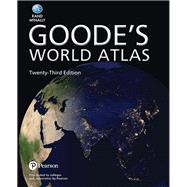For all geography courses.
Expand your geographic literacy with the gold standard in academic atlases
Goode’s World Atlas by Rand McNally helps students navigate through global and regional landscapes with ease. With color-coded headings and charts, brief introductions to each section, and more than 60 new reference and thematic maps, the 23rd edition gives you a comprehensive view of the world and its changing population and physical characteristics. Available soon in Pearson eText and Pearson Custom Library formats. Goode’s World Atlas has been the world’s premiere educational atlas since 1923, evolving with the world that shapes its content, and allowing for a deeper, more global understanding of geography.









